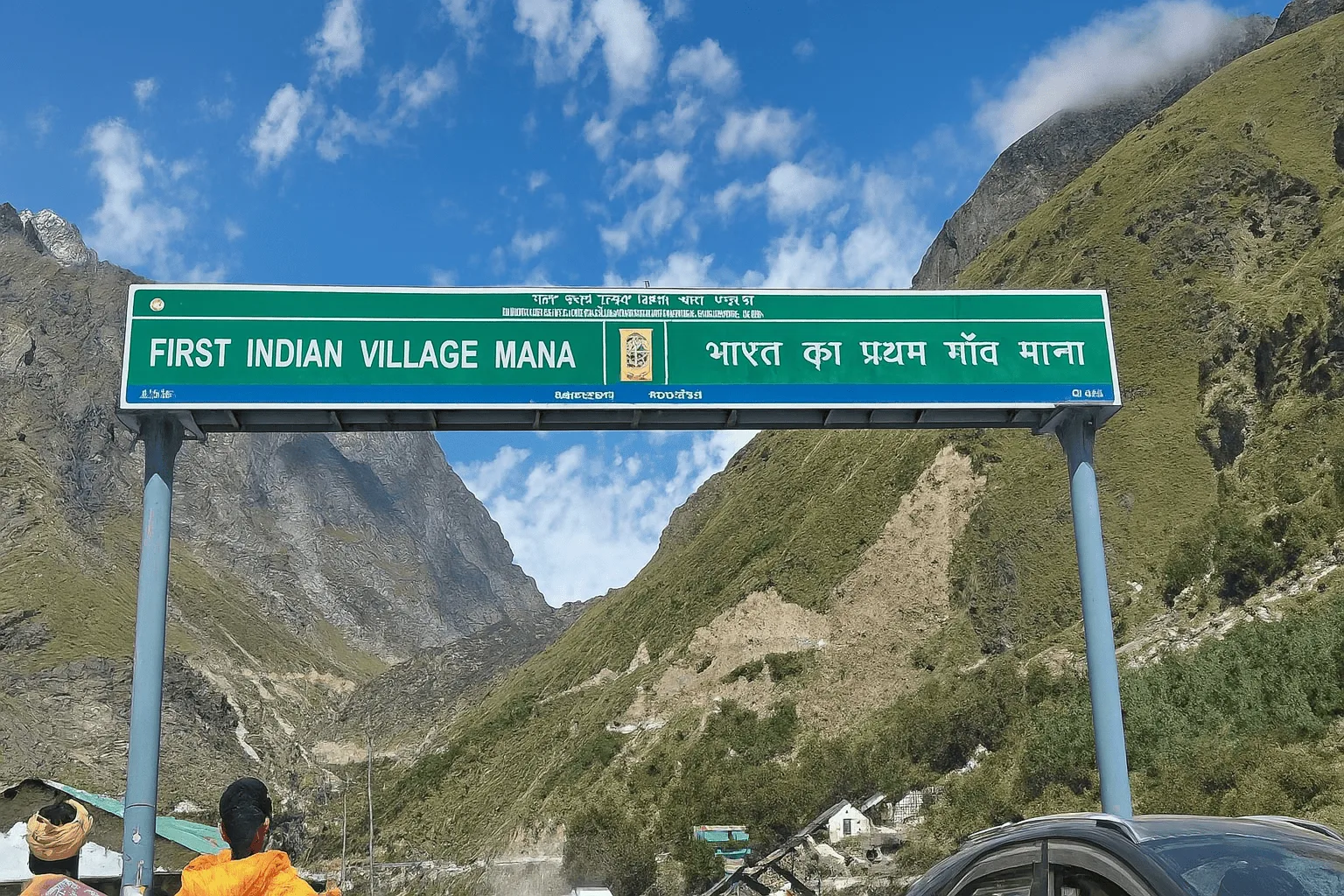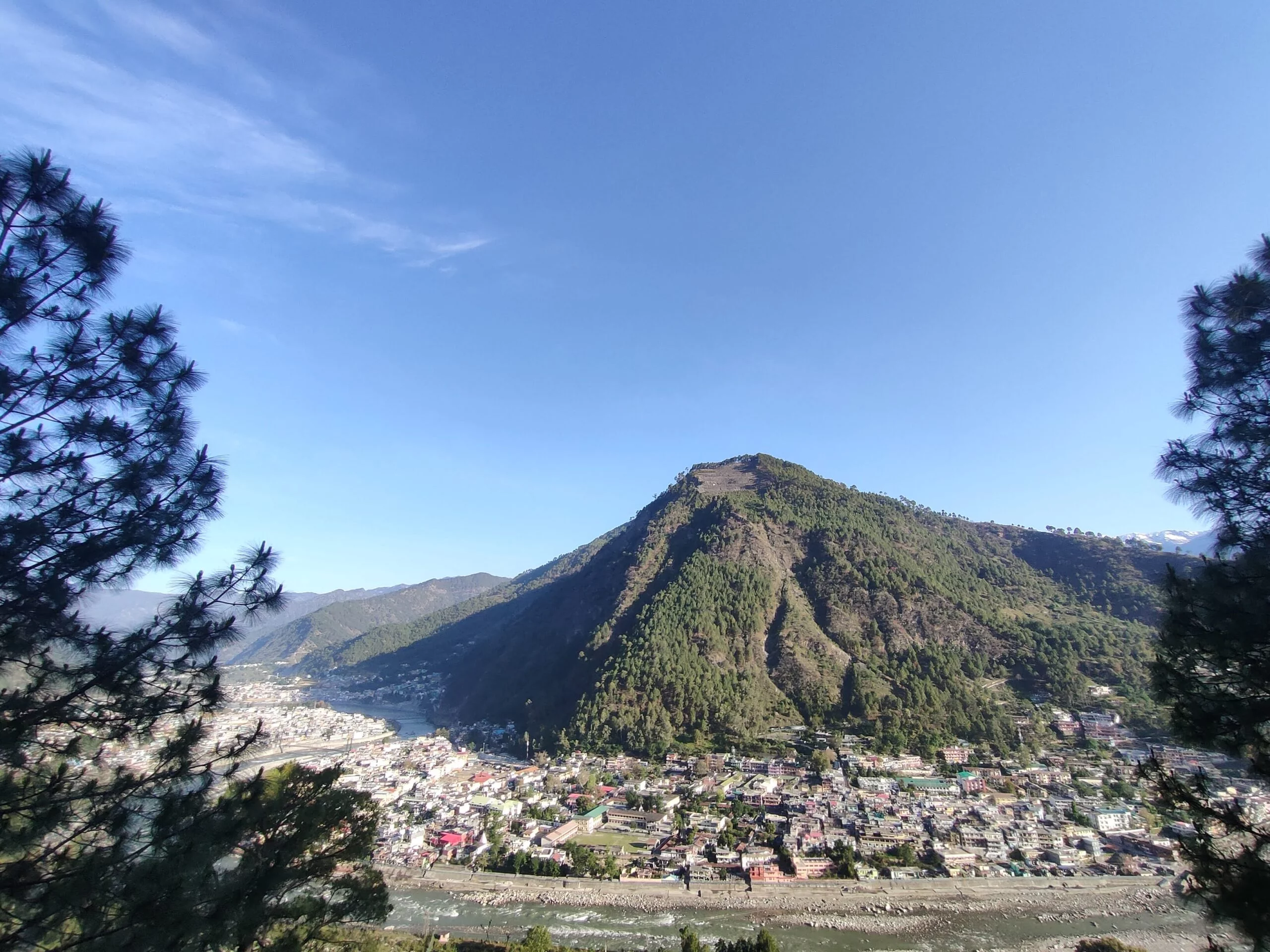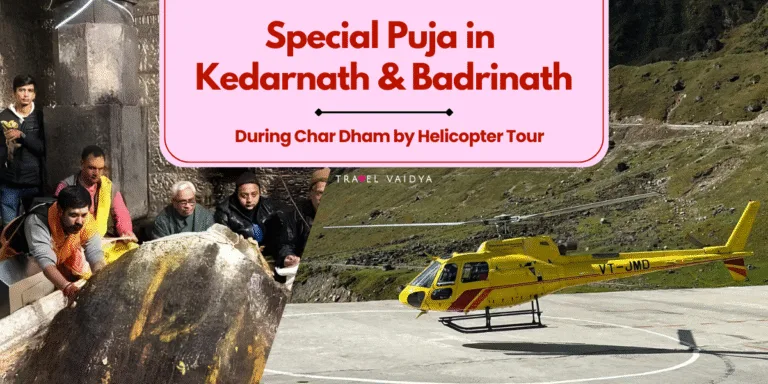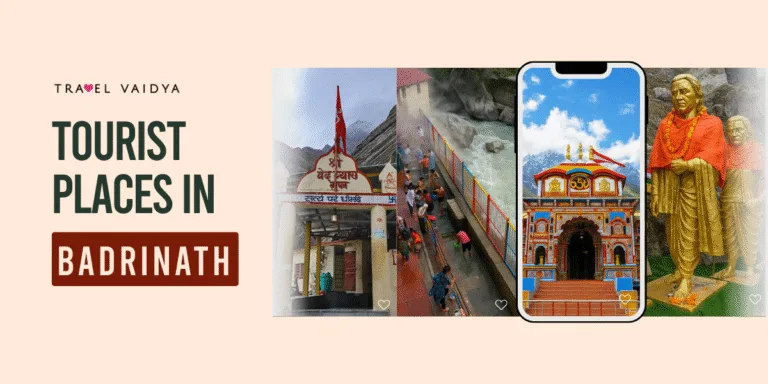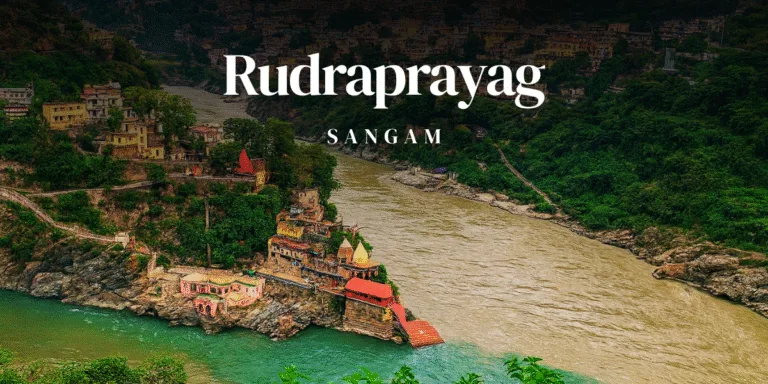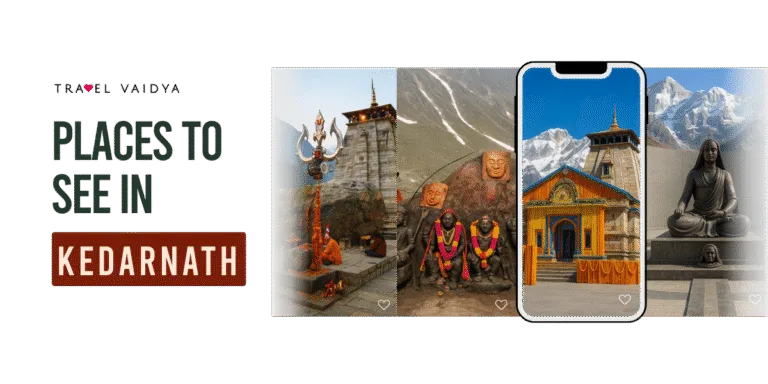Mana Village is the First Village of India, lies near the India-Tibet border and located just 4 km from Badrinath Temple in Uttarakhand. Mana is known for its spiritual significance and natural beauty. Surrounded by the Himalayas, Mana is famous for its connection to the Mahabharata. Legends say the Pandavas passed through here on their journey to heaven. The Saraswati River also flows from here, making it spiritually important. Visitors come to see mythological spots like Vyas Gufa, Bheem Pul, and the last tea shop of India. It is a quiet place where you can enjoy nature, history, and peaceful moments in the mountains.
- Just 4 km from Badrinath Temple
- Declared the “First Village of India” by BRO (border roads organisation)
- Connected to Mahabharata legends
- Surrounded by snow-capped peaks and ancient caves
- Popular for Vyas Gufa, Bheem Pul, Saraswati River, and more
Table of Contents
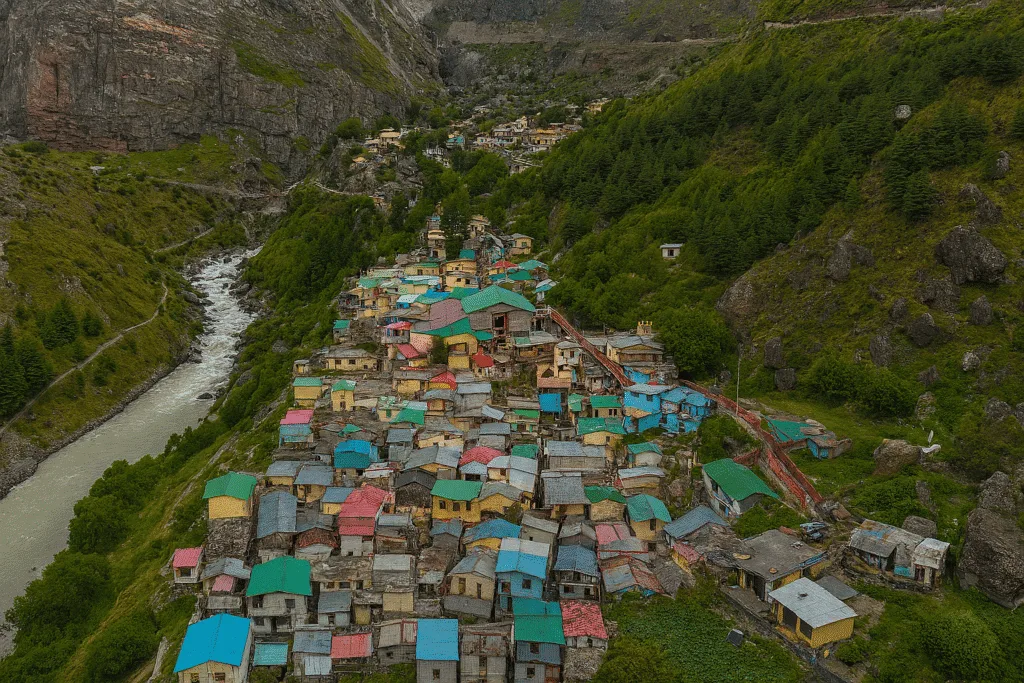
Where is Mana Village Located?
Mana Village is located in Chamoli district, Uttarakhand, about 3 km from Badrinath and close to the Indo-Tibetan border. Known as the first Indian village on the northern frontier, it sits at an altitude of around 3,200 meters. This culturally rich Himalayan village is popular among Char Dham pilgrims and trekkers visiting places like Vasudhara Falls and Satopanth Lake. Mana holds deep mythological significance with sites like Vyasa Gufa and Bhim Pul. It also serves as the last road-accessible point on NH-7. Home to the Bhotiya community, the village offers a glimpse into local life, spiritual heritage, and scenic beauty.
Key Highlights of Mana Village:
- Local Bhotiya culture, woolen handicrafts, and tea stalls
- Located 4 km from Badrinath in Uttarakhand
- Altitude: approx. 3,200 meters
- Known as “First Indian Village”
- Sites: Vyasa Gufa, Ganesh Gufa, Bhim Pul, Saraswati River
- Starting point for treks to Vasudhara & Satopanth
- Accessible via National Highway 7 (NH-7)
Why is Mana Village So Famous? More Than Just a Border Village
Mana Village holds deep mythological significance in Hindu belief, especially linked to the Mahabharata. It is believed that Ved Vyas composed the Mahabharata in Vyasa Gufa, a cave in Mana, while Lord Ganesha wrote it down in the nearby Ganesh Gufa. The village also marks the route of the Pandavas’ final journey to heaven (Swargarohini Yatra). According to legend, when Draupadi couldn’t cross the river, Bhim placed a massive stone to create a natural bridge, now known as Bhim Pul. Additionally, the Saraswati River emerges here, one of the few places where this sacred river is visible. These stories make Mana a spiritually powerful stop for pilgrims.
Why People Visit Mana:
- Vyasa Gufa – said to be where Mahabharata was written
- Bhim Pul – mythological stone bridge linked to Pandavas
- Saraswati River – one of the few visible origins of this sacred river
- Close to Badrinath Temple – just 4 km away
- Starting point for treks to Vasudhara Falls & Satopanth Tal
- Officially marked as “First Indian Village” by the Indian government
- Rich Bhotiya culture, woolen handicrafts, and border village feel
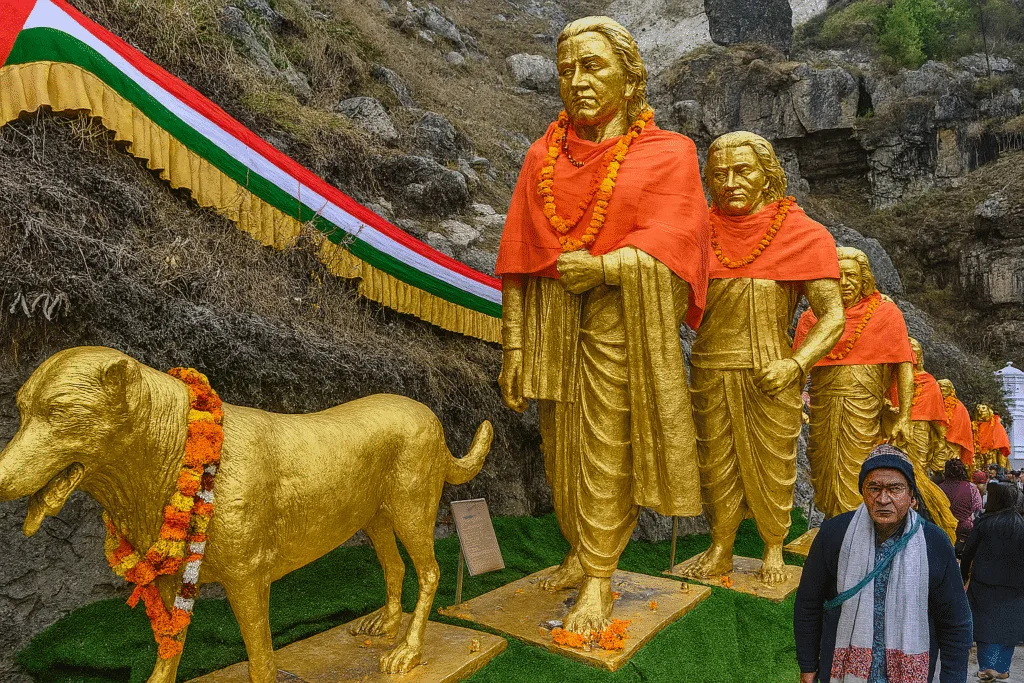
History and Mythology of Mana Village
Mana Village is known for its old trade history and strong link to Hindu mythology. It was once part of an India–Tibet trade route and is home to the Bhotiya community, who still follow traditional ways of living. In Hindu belief, Sage Ved Vyas stayed here to write the Mahabharata, and Lord Ganesha wrote it down inside Ganesh Gufa. The Pandavas are also said to have passed through Mana on their way to heaven, crossing a stone bridge called Bhim Pul. These stories make Mana special for both its history and spiritual value.
Highlights – History and Mythology of Mana Village:
- A village rich in both local history and epic stories
- Old India–Tibet trade route passed through Mana
- Inhabited by the Bhotiya tribe for generations
- Ved Vyas wrote the Mahabharata in Vyasa Gufa
- Lord Ganesha wrote it in Ganesh Gufa nearby
- Pandavas crossed through Mana during their last journey
- Bhim Pul was placed by Bhim for Draupadi to cross the river
- Saraswati River flows from here, mentioned in Vedic texts
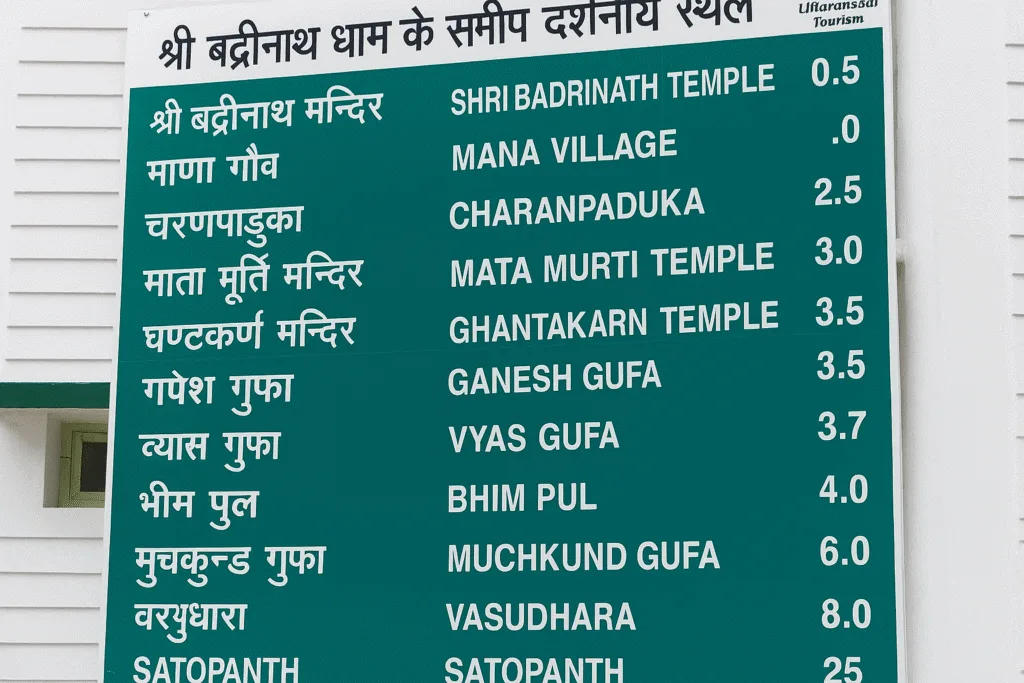
How to Reach Mana Village
Mana Village is accessible by road and is located 4 km away from Badrinath Temple in Chamoli district, Uttarakhand. It lies on National Highway 7 (NH-7) and can be reached by taxi or bus from Haridwar, Rishikesh, Dehradun, or Joshimath. The nearest airport is Jolly Grant Airport in Dehradun which 310 Kms away from the village and nearest railway station is Haridwar/Rishikesh railway station which is 320 Kms away from the village. The route remains open from May to October, while roads close in winter due to heavy snowfall.
By Road:
- Badrinath to Mana Village Distance: 4 km (10 minutes by car, 30 min walk)
- Haridwar to Mana Village Distance: 320 km (10–12 hours)
- Dehradun Airport to Mana Village Distance: 310 km (10-12 hours)
- Delhi Airport to Mana Village Distance: 540 km
By Train:
- Nearest Railway Station: Rishikesh (310 km)
- Haridwar Railway Station (320 km)
By Air:
- Nearest Airport: Jolly Grant Airport, Dehradun (310 km)
- Taxis available from the airport to Badrinath
Best Time to Visit Mana Village
The best time to visit Mana Village is from May to mid-November, when the roads are open and the weather is pleasant. During May, June, September, and October, temperatures range between 5°C to 20°C, making it ideal for sightseeing, trekking, and photography. Avoid July and August, as the region receives heavy rainfall (8°C to 18°C) and is prone to landslides. In winter (November to April), temperatures drop sharply to -10°C to 5°C, and the village becomes inaccessible due to snow-covered roads and harsh weather.
Season-wise Travel Guide to Mana Village:
Winter (Nov–Apr):
Temp: -10°C to 5°C
Heavy snowfall, roads closed, village not accessible
Summer (May–June):
Temp: 10°C to 20°C
Clear skies, ideal for travel and sightseeing
Monsoon (July–August):
Temp: 8°C to 18°C
Frequent rains, high risk of landslides – avoid travel
Autumn (Sept–Oct):
Temp: 5°C to 15°C
Cool weather, perfect for trekking and photography
What to See in Mana Village
Mana may be a small mountain village, but it is full of interesting places connected to ancient Hindu stories. Most of the spots here are linked to the Mahabharata and attract spiritual seekers, curious travelers, and trekkers alike. Here’s a simple guide to what you should not miss when visiting Mana:
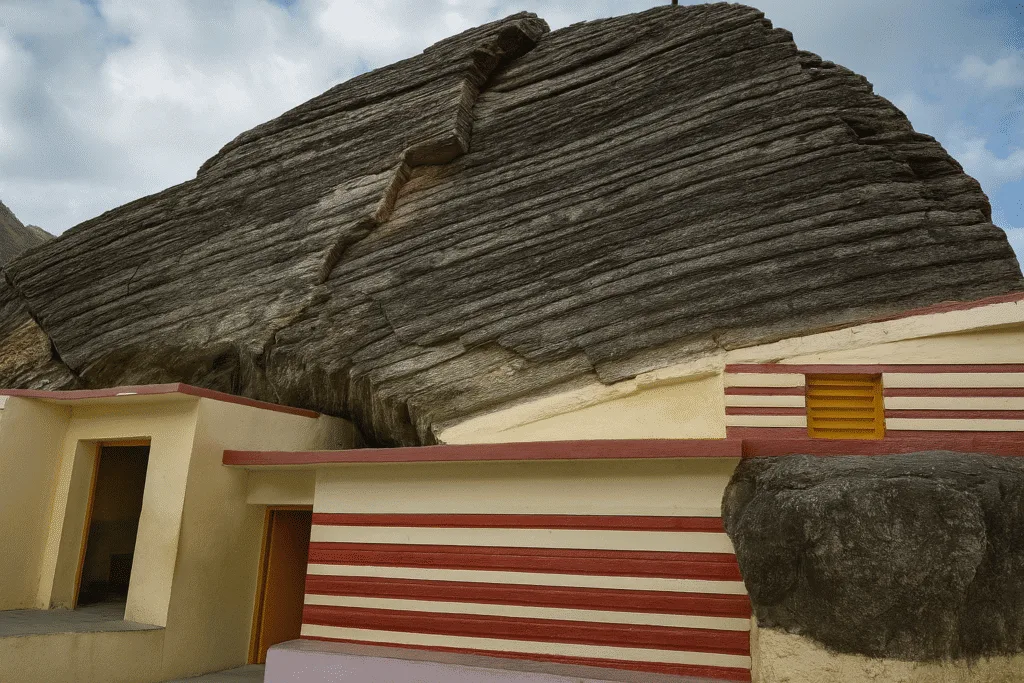
Vyas Gufa
This ancient cave is believed to be the spot where Sage Ved Vyas composed the Mahabharata. Inside, there’s a small shrine and stone markings said to resemble scriptures. The cave is calm, with a spiritual feel, and holds great importance for Hindu devotees.
- Distance: ~500 meters from Mana parking area
- Short uphill walk from the village
- Known for: Mahabharata connection and spiritual energy
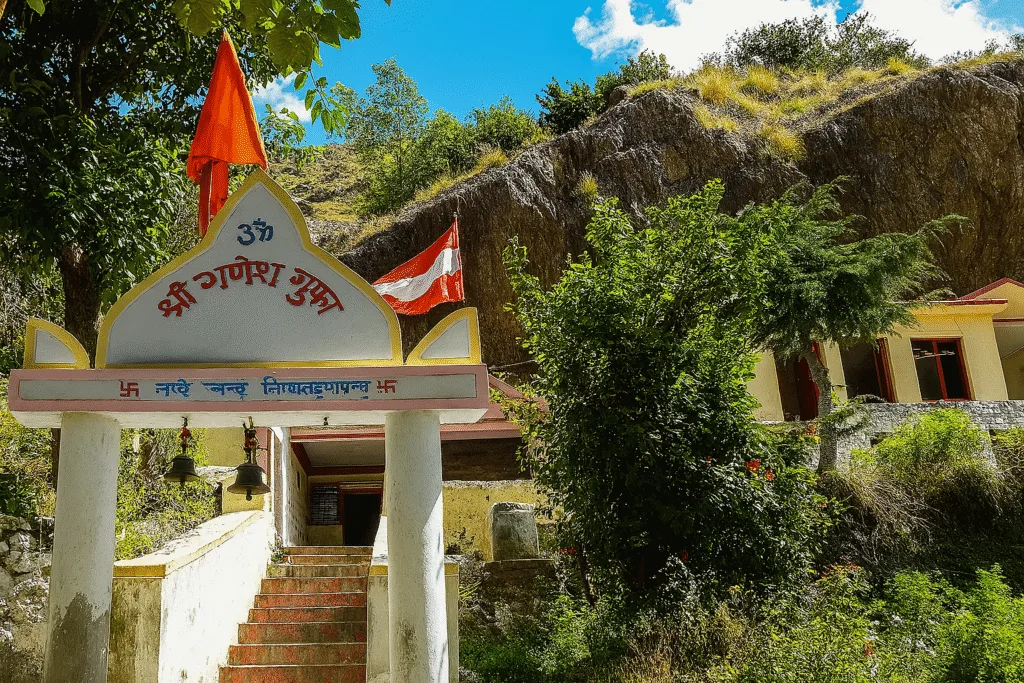
Ganesh Gufa
Located close to Vyas Gufa, this cave is where Lord Ganesha is said to have written the Mahabharata as Ved Vyas dictated it. The cave is small but clean, with a Ganesh idol inside and stone seating. It’s quiet and often less crowded than Vyas Gufa.
- Distance: Just 100 meters from Vyas Gufa
- Peaceful and scenic surroundings
- Known for: Connection to Lord Ganesha and ancient writing
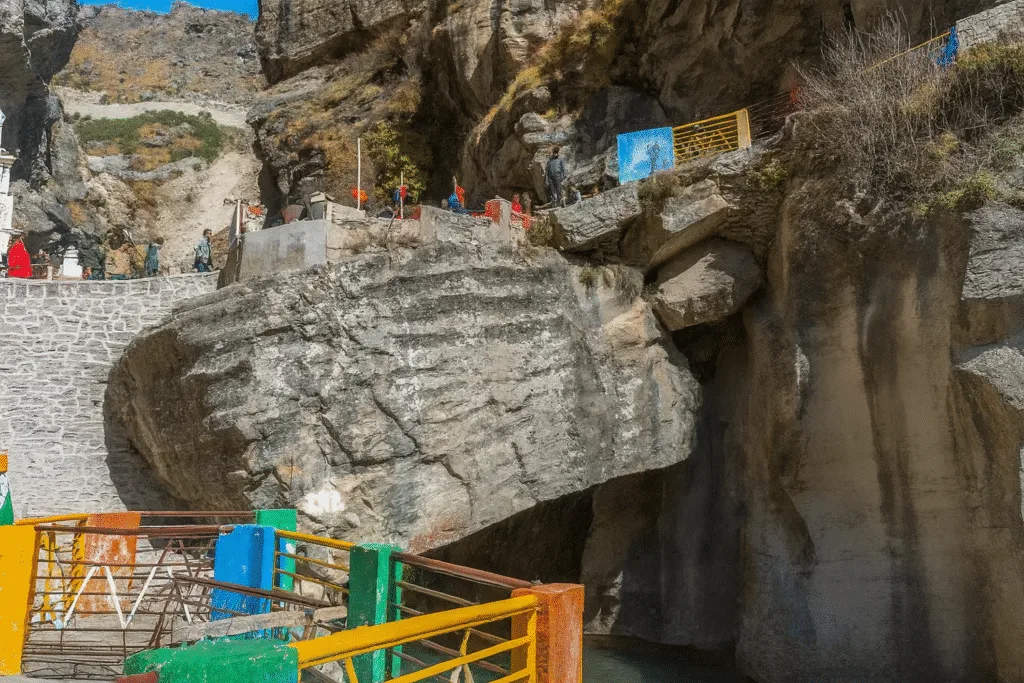
Bheem Pul
This is a natural rock bridge over the Saraswati River, believed to have been placed by Bhim for Draupadi during the Pandavas’ final journey. The river gushes below with force, and the bridge is safe to walk across. It’s one of the most visited photo spots in Mana.
- Distance: ~700 meters from Mana entry
- Located near Saraswati River origin
- Known for: Mythological story and dramatic landscape
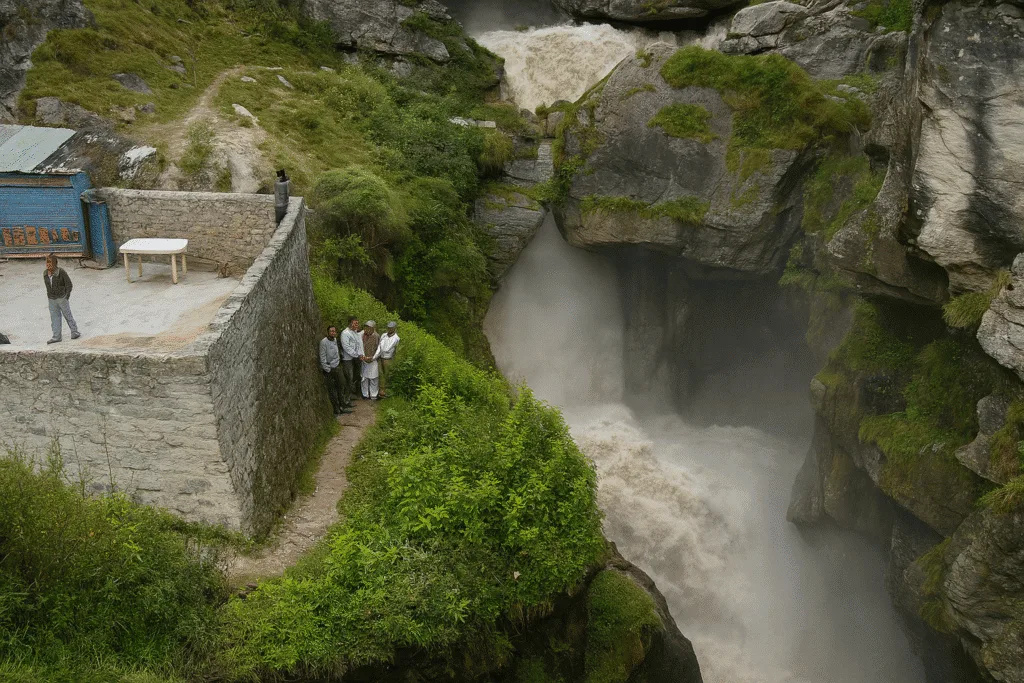
Origin of Saraswati River
Near Bhim Pul, the Saraswati River emerges from a rocky crevice, flowing with intense speed. According to Vedic texts, this sacred river mostly flows underground, and its visible presence here is rare and considered holy.
- Location: Just beside Bhim Pul
- Strong flow and loud sound of water
- Known for: One of the few visible origins of the Saraswati River
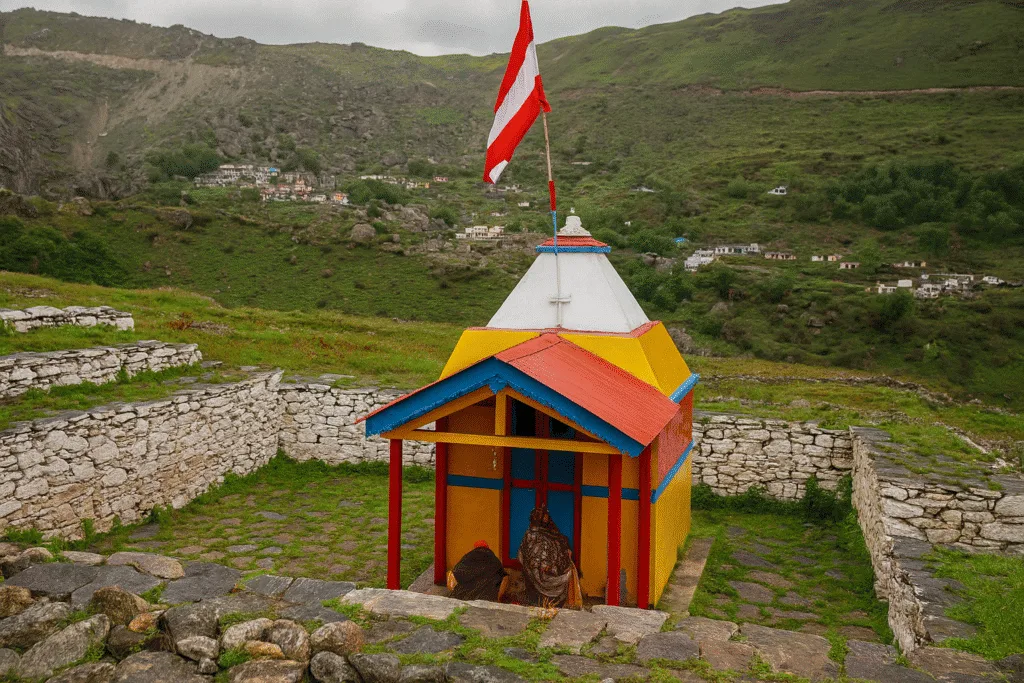
Mata Murti Temple
Located just 4 km before Badrinath, this temple is dedicated to the mother of Lord Narayan (Mata Murti). According to belief, she meditated here to request Lord Vishnu to take birth as her son. Every year, a special Mata Murti Ka Mela is held, and thousands of devotees attend. The temple is small but peaceful, surrounded by hills and the Alaknanda River.
- Distance: ~4 km from Mana
- Can be visited before or after Badrinath Darshan
- Known for: Spiritual significance and annual fair
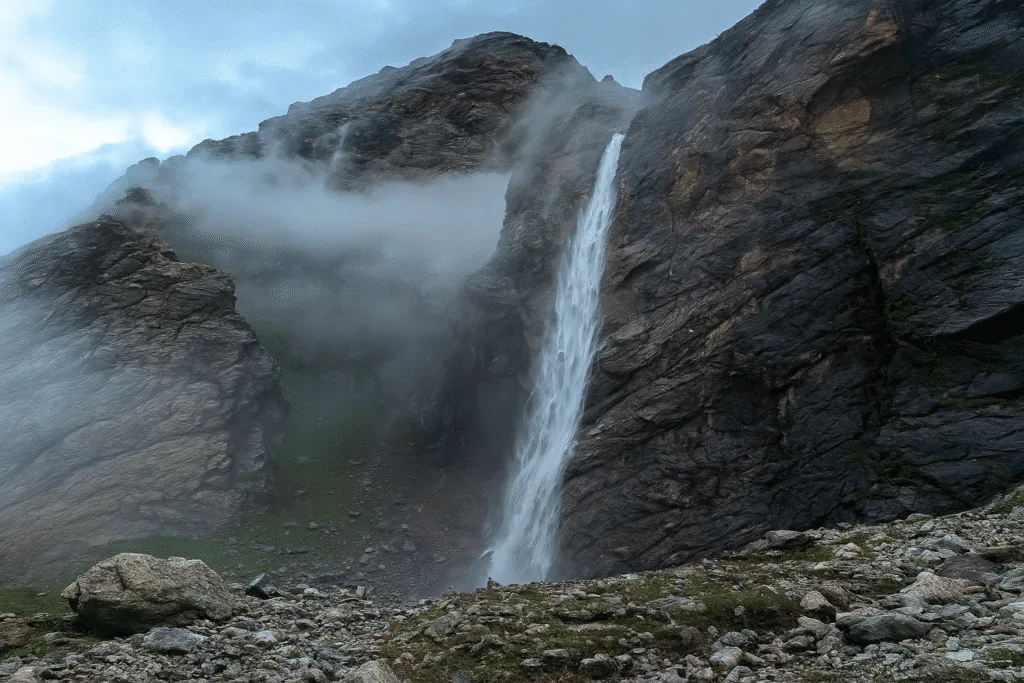
Vasudhara Falls
Vasudhara falls is located about 6 km from Mana and is said to be the place where the Pandavas rested during their final journey. The fall drops from a height of about 400 feet and can be reached via a short trek from Mana. It is believed that only those with a pure heart can feel the drops of Vasudhara.
- Distance: 6 km trek from Mana
- Trek Level: Moderate
- Best time: May to October (carry water and start early)
- Myth: Associated with Pandavas’ Swargarohini Yatra
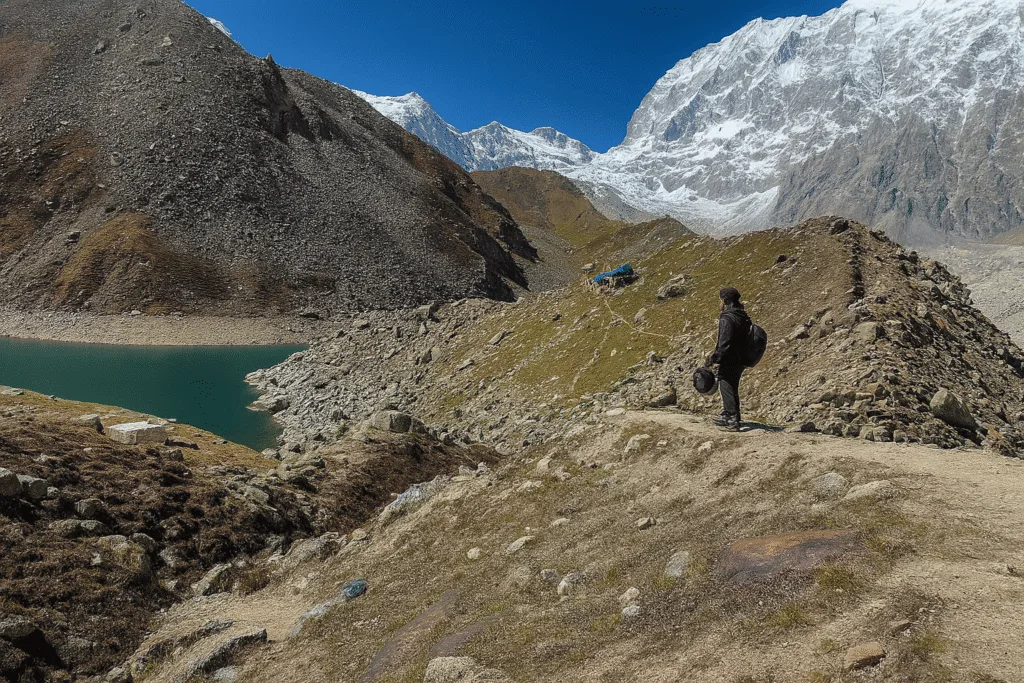
Swargarohini Path
This is the mythical path the Pandavas took to heaven, believed to start from Mana Village. While the full trail to Swargarohini Glacier and Satopanth Tal is challenging and requires a proper trek plan, the first section from Mana to Lakshmi Van and Satopanth is accessible with a guide.
- Trek starts from Mana village
- Satopanth Tal is ~25 km from Mana
- Requires 2–3 days, camping gear, and a local guide
- Myth: Only Yudhishthira and his dog reached heaven alive
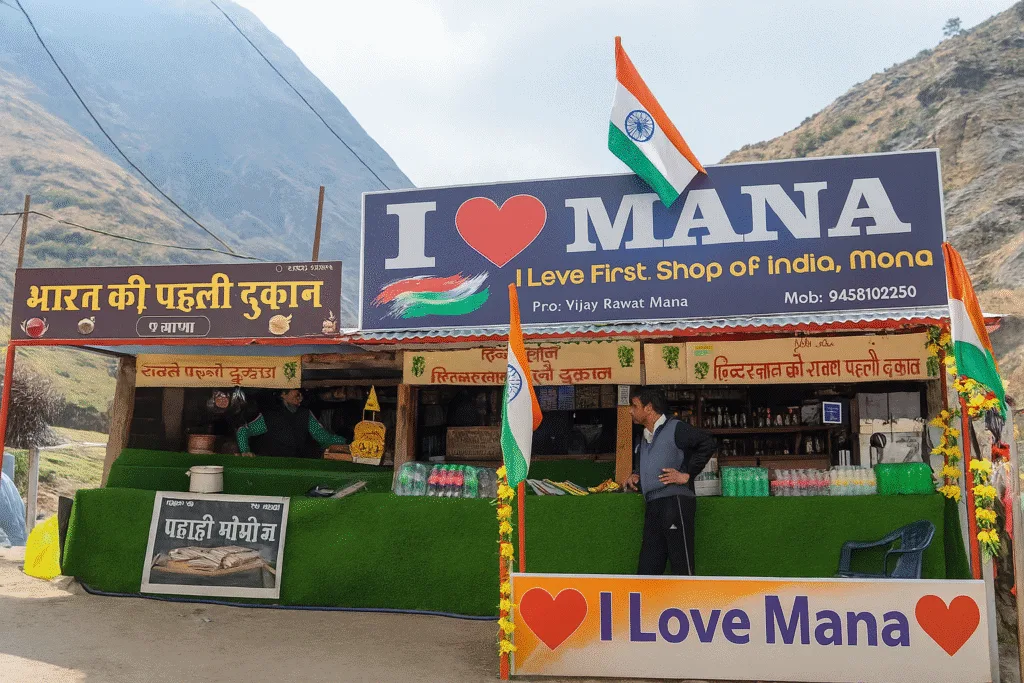
First Tea Shop of India
This small tea stall proudly calls itself the First Tea Shop before the Indo-Tibet border. It’s a friendly stop where you can enjoy hot chai, take pictures, and interact with locals. It’s become a symbol of patriotic pride and travel achievement.
- Located at the end of Mana village road
- Popular photo spot for tourists
- Known for: Location and symbolic “first tea point” of India
Local Culture and Traditions in Mana Village
Mana is home to the Bhotiya tribe, who are of Indo-Tibetan origin. They live in stone houses, follow old customs, and have a deep faith in religion. Most villagers speak Bhotia, but they also understand Garhwali and Hindi. During the tourist season, they sell handmade woollen clothes, herbs, and local tea. Life here is simple, quiet, and deeply connected to nature and faith.
Cultural Insights:
- Handmade woollen caps, socks, and sweaters are sold by locals
- Food is vegetarian, cooked on wood-fired stoves
- People are polite but private—always ask before clicking photos
- Festivals are small, focused around Badrinath temple and local gods
Practical Travel Tips for Visiting Mana Village
Visiting Mana is rewarding but requires some planning. Since the village is close to a high-altitude region, prepare accordingly. Accommodations are limited and mostly available in Badrinath. Carry basic supplies and dress in layers to stay warm.
Travel Tips:
- Stay overnight in Badrinath for convenience
- No ATMs in Mana; withdraw cash in Joshimath
- Phone signals may be weak; Jio works best
- Carry warm clothes even in summer
- Walking is required to see most sites; wear comfortable shoes
- Respect local customs and don’t litter
About Travel Vaidya – Trusted Travel Experts of Uttarakhand
Travel Vaidya is a Dehradun-based travel company with deep roots across Uttarakhand. For over 9 years, we’ve helped families, senior citizens, and spiritual travelers explore places like Char Dham, Auli, Jim Corbett, Nainital, Kausani, Almora, and Ranikhet with confidence.
We’re not a call center or big-brand OTA—we’re a small team that builds practical, experience-based itineraries. Every plan is shaped by local knowledge, seasonal awareness, and what actually works on-ground.
From temple visits to hotel check-ins, we handle logistics, route planning, and day-wise support—especially for elders and family travelers. We share what we know from living here, not from reading about it.
This guide is part of our effort to make travel in Uttarakhand easier to understand and plan.


